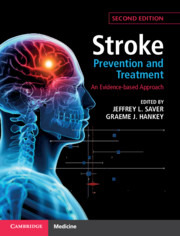Book contents
- Stroke Prevention and Treatment
- Stroke Prevention and Treatment
- Copyright page
- Dedication
- Contents
- Contributors
- Preface
- Part I Foundations
- Part II Systems of Care
- Part III Acute Treatment of Ischaemic Stroke and Transient Ischaemic Attack
- Chapter 5 Supportive Care during Acute Cerebral Ischaemia
- Chapter 6 Reperfusion of Ischaemic Brain by Intravenous Thrombolysis
- Chapter 7 Reperfusion of the Ischaemic Brain by Endovascular Thrombectomy and Thrombolysis
- Chapter 8 Collateral Flow Enhancement: Blood Pressure Lowering and Alteration of Blood Viscosity
- Chapter 9 Acute Antiplatelet Therapy for the Treatment of Ischaemic Stroke and Transient Ischaemic Attack
- Chapter 10 Acute Anticoagulant Therapy for the Treatment of Acute Ischaemic Stroke and Transient Ischaemic Attack
- Chapter 11 Treatment of Brain Oedema
- Chapter 12 Neuroprotection for Acute Brain Ischaemia
- Part IV Acute Treatment of Haemorrhagic Stroke
- Part V Prevention
- Part VI Stroke Rehabilitation and Recovery
- Index
- References
Chapter 8 - Collateral Flow Enhancement: Blood Pressure Lowering and Alteration of Blood Viscosity
from Part III - Acute Treatment of Ischaemic Stroke and Transient Ischaemic Attack
Published online by Cambridge University Press: 15 December 2020
- Stroke Prevention and Treatment
- Stroke Prevention and Treatment
- Copyright page
- Dedication
- Contents
- Contributors
- Preface
- Part I Foundations
- Part II Systems of Care
- Part III Acute Treatment of Ischaemic Stroke and Transient Ischaemic Attack
- Chapter 5 Supportive Care during Acute Cerebral Ischaemia
- Chapter 6 Reperfusion of Ischaemic Brain by Intravenous Thrombolysis
- Chapter 7 Reperfusion of the Ischaemic Brain by Endovascular Thrombectomy and Thrombolysis
- Chapter 8 Collateral Flow Enhancement: Blood Pressure Lowering and Alteration of Blood Viscosity
- Chapter 9 Acute Antiplatelet Therapy for the Treatment of Ischaemic Stroke and Transient Ischaemic Attack
- Chapter 10 Acute Anticoagulant Therapy for the Treatment of Acute Ischaemic Stroke and Transient Ischaemic Attack
- Chapter 11 Treatment of Brain Oedema
- Chapter 12 Neuroprotection for Acute Brain Ischaemia
- Part IV Acute Treatment of Haemorrhagic Stroke
- Part V Prevention
- Part VI Stroke Rehabilitation and Recovery
- Index
- References
Summary
In acute ischaemic stroke, cerebral blood flow autoregulatory mechanisms may be disrupted so that cerebral perfusion becomes reliant on systemic blood pressure. Too low blood pressure may lead to progression of the infarction and too high blood pressure may cause cerebral oedema or haemorrhagic transformation of the infarct. In patients with BP = 220/120 mm Hg who do not receive intravenous thrombolysis, it is reasonable to lower BP by 15% during the first 24 hours after stroke onset. Patients who have elevated blood pressure and are otherwise eligible for treatment with intravenous rt-PA should have their blood pressure lowered so that systolic blood pressure is < 185 mm Hg and their diastolic blood pressure is < 110 mm Hg before thrombolytic treatment is administered. Acute stroke patients should be assessed for dehydration and a fluid balance chart should be kept. Underlying causes of hypotension should be treated rapidly. There is no beneficial effect of hemodilution treatment for acute ischaemic stroke. Fibrinogen-depleting agents that reduce viscosity may marginally reduce risk of recurrent ischaemic stroke, but more greatly increases symptomatic intracranial haemorrhage. Methylxanthine derivatives such as pentoxyphylline and propenofylline that reduce viscosity and produce vasodilation have insufficient evidence to support their use.
Keywords
- Type
- Chapter
- Information
- Stroke Prevention and TreatmentAn Evidence-based Approach, pp. 146 - 153Publisher: Cambridge University PressPrint publication year: 2020

